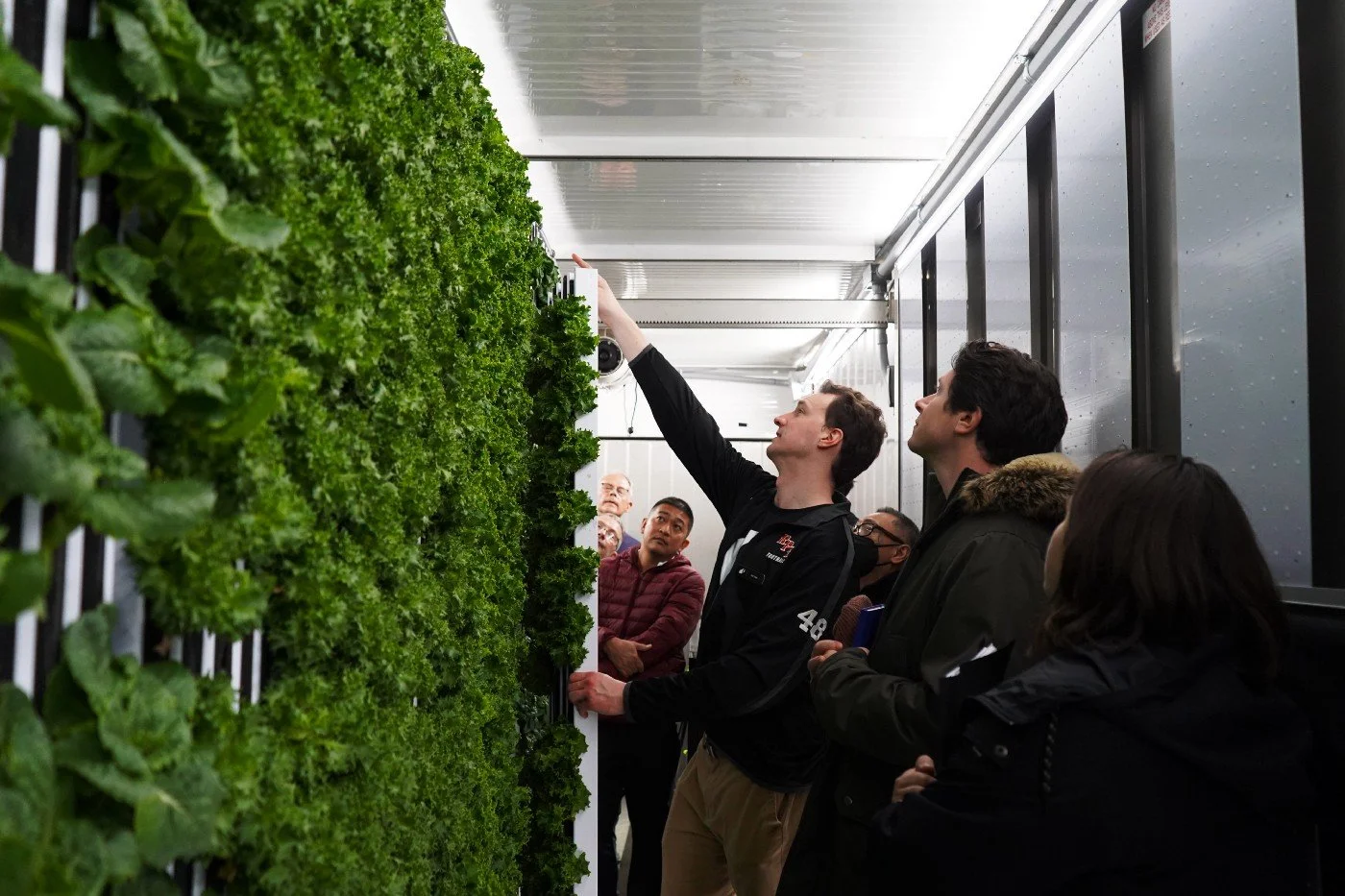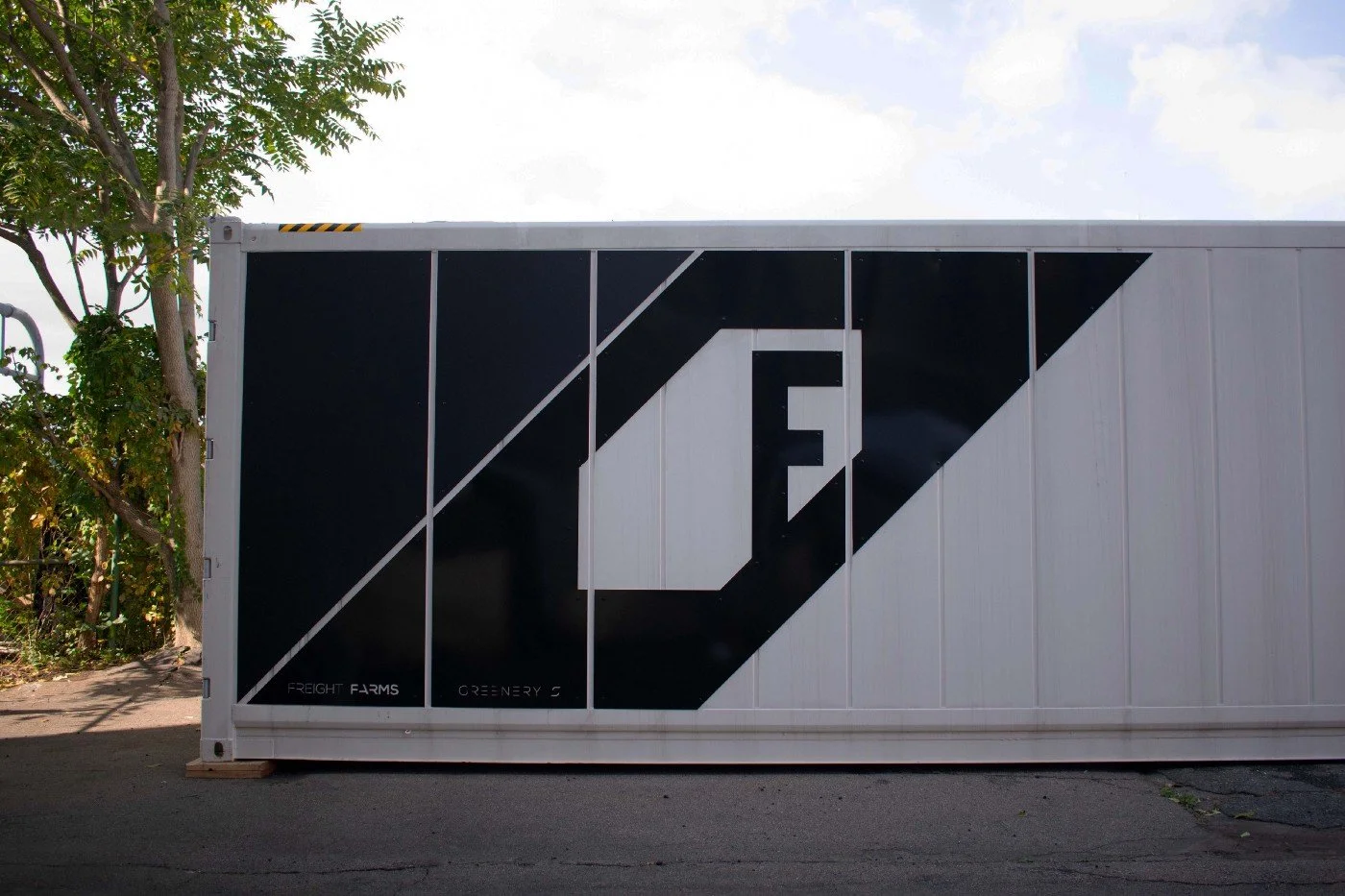Move Farms, Not Food
You’ll Feed Them For A Lifetime.
The old proverbial saying goes, “Give a man a fish and he will eat for a day. Teach a man how to fish and you feed him for a lifetime.” The proverb has contested origins — you’ll see it attributed to Chinese philosophy as well as the Bible — but no proof exists for either. Some identify the first version of the saying in a story by Anne Isabella Ritchie in the late 1800s. Regardless of its true provenance, the message remains the same: Rather than enable, we must strive to empower — for sharing knowledge and resources is the gateway to independence and sustainability.
Here at Freight Farms, we believe strongly in the proverb’s underlying message, but instead of fish, we focus on fresh food. We’re on a mission to empower communities through farming and democratize access to fresh, local food.
Farmers sell lettuce at the local farmers market (Image credit: Nanue’s Farm)
We believe that everyone should be able to access fresh and healthy food, and that this access should be available year-round. However, we see simply giving people fresh food as an inadequate solution. Shipping to remote communities presents a major underlying problem: The global food system is so unstable that it could crack at any moment.
That’s why we move farms, not food.
You might be wondering, “How in the world does someone move a farm?”
Our farms are modular farms, built inside containers that can be shipped anywhere. Only unlike food — shipped everywhere, every week — our farms are shipped once, and when they arrive, they can be put to work providing fresh food for the farmer and their community.
Perhaps a better question would be: Where in the world does someone move a farm? (The answer: anywhere.)
The inside of a modular farm (Image credit: Freight Farms)
We believe that moving the farms, rather than food, may alleviate a litany of issues within our food supply chain and contribute to a more sustainable collective future.
These food supply chain issues are so ingrained in the way we live that they may not be evident at first glance. For that reason, we’re going to explore them briefly.
Food moves far. Really far — on average, 1,500 miles before reaching the consumer. Not only does the process of moving food at such a great distance release tons of bad-for-the-environment carbon emissions, but it also means there are numerous opportunities for things to go awry.
Volatile weather remains a constant threat that is completely out of our control. Natural disasters, storms, droughts, early freezes — all impact our food and our food supply chain.
We accept that standard fresh food is, well, not so fresh. By the time food reaches the end of its 1,500-mile journey, it’s often days away from turning to dark brown-green sludge or sprouting dubious white fuzz. It doesn’t have to be this way.
Outbreaks of foodborne illnesses such as E. Coli and salmonella bring food supply to a grinding halt, affecting people everywhere. These outbreaks are a direct result of the centralized nature of our global food system.
Our supply chain has become, to some extent, one of pay-to-play. Food deserts (areas without easy access to affordable, healthy food options) are no coincidence; often they are areas that grocery stores perceive economically unable to support a business offering fresh food options. If a community can’t pay the hefty price of our global supply chain, it is penalized by being denied the mere opportunity for fresh produce. If you believe in the theory that proper nutrition and food access increases stability, then this is akin to perpetuating the cycle of poverty.
Now that we’ve dug in, let’s paint a picture.
A truck with a trailer full of lettuce travels a handful of days and a bit more than 1,500 miles to get from the farm on which it’s grown in California to a Minnesotan consumer. But when a heavy blizzard maroons the lettuce midway through Wyoming, the grocery store shelves of the Minnesotans are empty of lettuce for a couple days. By the time the waylaid lettuce finally makes it to Minnesota, much of it goes limp soon after it arrives. Shoppers wrinkle their noses in disgust when they see their newly purchased greens turn to slime on their fridge shelves. Everyone, that is, except families in a low-income neighborhood in St. Paul — which never had any fresh lettuce to begin with.
We spoke earlier of a democratic food system. This is not that.
We think that decentralizing our food system and moving farms rather than food could mitigate some of these problems. Here’s how:
Moving farms once instead of food many, many, many times significantly reduces carbon emissions.
When food is grown and consumed locally, extreme weather in distant locales, such as a snowstorm in Wyoming or wildfires in California, isn’t going to affect consumers hundreds of miles away. Take our friends the Minnesotans. If those Minnesotans have a nearby container farm, even a snowstorm in Minnesota will have minimal impact on their access to fresh food.
Food is at its freshest and healthiest (and most delicious) when it doesn’t need to travel far to reach you. Hyper-local produce, harvested and sold locally, has nearly 2–3 weeks’ additional shelf life compared to standard “fresh” produce trucked across the country. So even if those Minnesotans get dumped with two feet of snow and lettuce sales are delayed by a day or two, that lettuce will still be happily crisp when snowed-in residents finally shovel themselves out. Locally grown produce means significantly less food waste and significantly better food for communities.
Local, small-scale farming leads to higher health and safety standards and fewer opportunities for exposure to sources of sickness-causing bacteria. When a farmer is a part of the community they are serving, there is far greater care put into the end result — meaning safer food and safer communities.
For food deserts, local solutions — and in particular, hydroponic farming — mean an opportunity to grow food for the community. While starting a farm does require capital, available food access grants make this more achievable than it may seem. And as a bonus, especially in those economically depressed areas with a dearth of job ability, container farms can also provide valuable jobs for residents.
Basil growing strong in a Freight Farm despite snow outside! (Image credit: ICA Åre)
The key here is a distributed network of modular farms.
Distribution, decentralization — and empowerment. This is what moving farms, not food, achieves.
You may be thinking, This is all well and good, but farming is hard! It’s tough work with a tough learning curve. Aren’t you being a little, well, idealistic?
It’s a fair question, yet the answer lies in our original proverb: “Give a man a fish and he will eat for a day. Teach a man how to fish and you feed him for a lifetime.”
The teaching portion of that phrase is important. This is why we don’t just move farms — we also train farmers and support them as they begin growing. It’s easier than you might think. We designed our modular farms to simplify farming by integrating numerous automations to make growing food easier and more accessible. We utilize controlled environment agriculture in our farms not only because it consistently creates perfect growing conditions, but also because it reduces the stress and risk in farming. Container farmers don’t have to constantly worry about the weather and how it will affect their plants. They can manage the weather in the farm with the touch of a button on an app, but they rarely need to — the app moderates it all for them.
The outside of a modular container farm (Image credit: Freight Farms)
Freight Farmers make an incredible impact in communities around the world.
They are a constant source of inspiration and are paving the way for the future of food and farming. Each new farmer brings their community closer to the ideal of a secure, resilient, and independent local food system.
Join us in this inspiring refrain. As the proverbial wisdom implies: Give a man food and he will eat for a day. Give a man, a woman, anyone a farm and they will eat for a lifetime.
Feeling inspired? Support a local farmer, learn to grow, or consider starting a modular farm yourself.
Want to learn more about Freight Farmers? Take a look at our case studies and our Grow Food Here video series.





